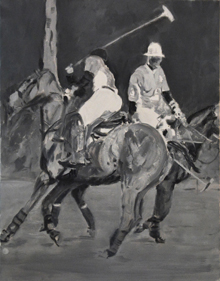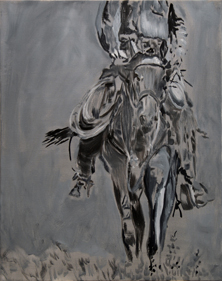Horse/Man Series
I am moved by the mustang in the wild that can hear helicopters a mile away, and knows every blindspot in the mesa.Let me begin by explaining why I chose the subject and settled on grisaille. I grew up on a farm in North Carolina, where we bred and raised thoroughbreds, which I rode and helped train. My mother still has a working farm, off-the-grid, in Wanship, where she breeds alpaca and Icelandic sheep, and weaves and reads Melanie Klein by candlelight. The Horse/Man series explores the question of domestication. A “domesticated” horse is born full of spirit, which its owner sets out to break, in a systematic fashion. There are good and bad reasons for this, and I am not sure that I fully know where I stand. It is this ambivalence that I sought to examine. At the same time, I wanted to see the extent to which my experience as a rider could help me capture the deep and tacit trust between horse and rider, and the athleticism of the polo pony and the thoroughbred.
My initial goal: to examine the relationship between color and movement. I had at least three false starts using a full palette. I continued. Then my Netflix queue reached "Shadow of the Thin Man", in which Nick, Nora and Asta solved the race-track murder of a jockey. Black and white, suddenly seemed right. Myrna Loy’s flowing dresses, Asta’s fluffy fur, and William Powell’s half-cocked expression (after his third vodka martini) would definitely lose something, if they were rendered in color.
While working at Calvin Klein, I had learned an important fact: color matters only when you cannot make your point in black and white. Of course, beautiful models are beautiful in any color—but so are horses and riders. So with a nod to Nick and Nora, I started with a couple of horse-track paintings—"Chasing Diamonds" and "Gate Bound".
A polo player once told me that he wished that the spectators paid more attention to the match instead of spending so much time admiring each other and clicking away at their smartphones. So, as I continued with the series, I became increasingly concerned with the relationship between the spectators and players. "The Pass", "Breakaway", "Sunday Afternoon", and "Helios" were all attempts to deal with this general problem. I also became interested in the opposite problem: spectators who are so intent on the proceedings that they are oblivious to each other. This led to "The Match"



